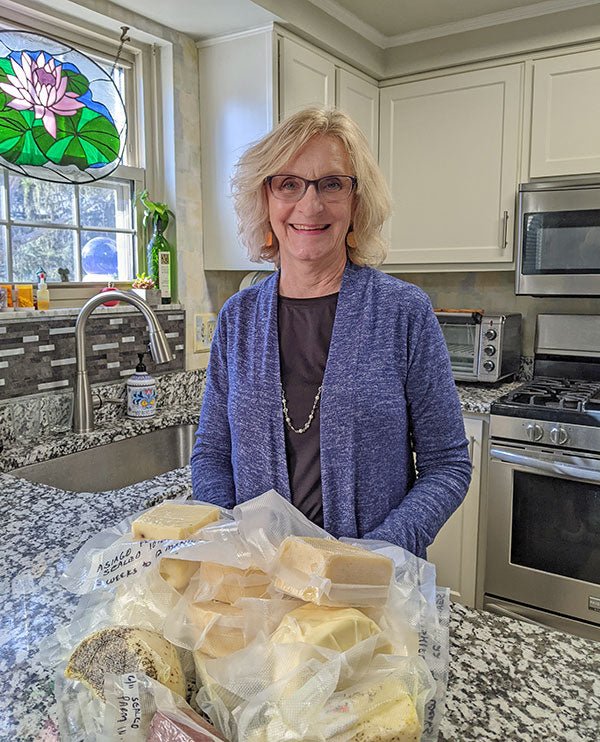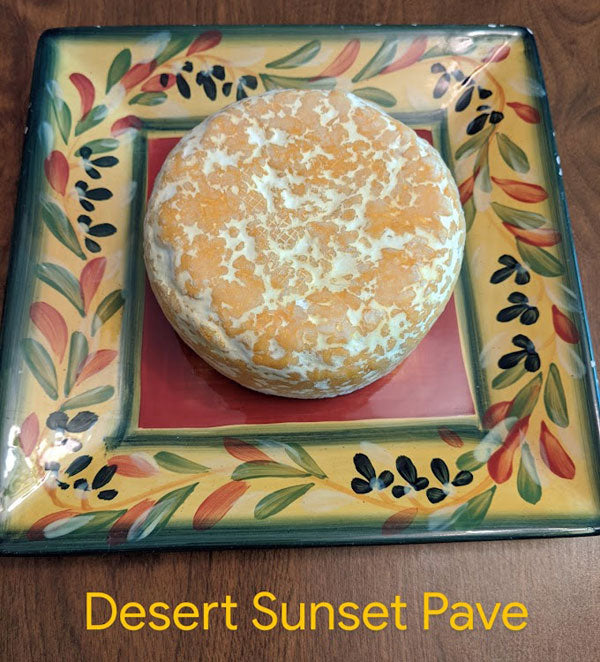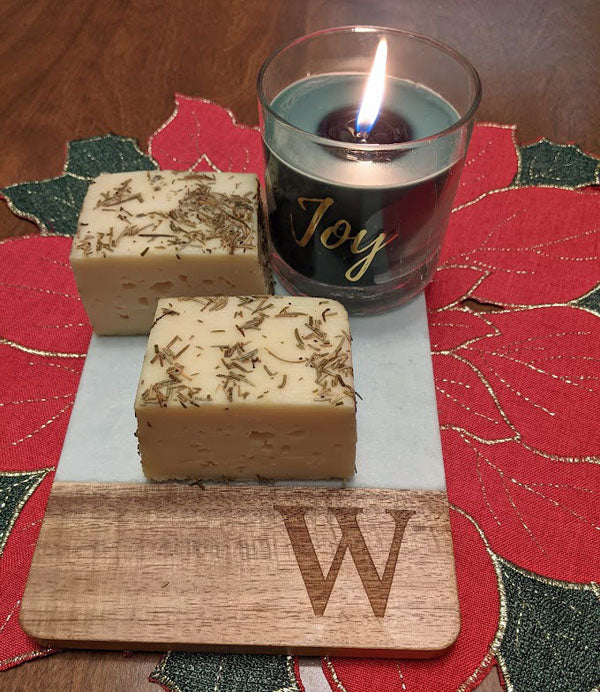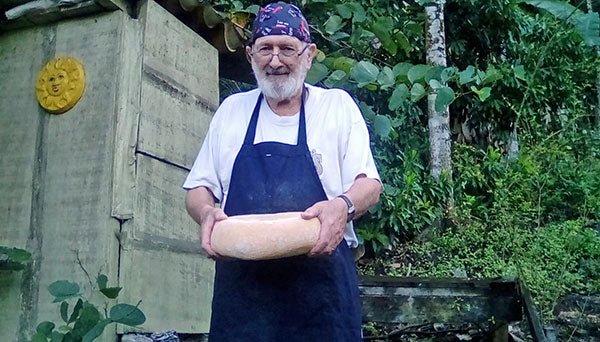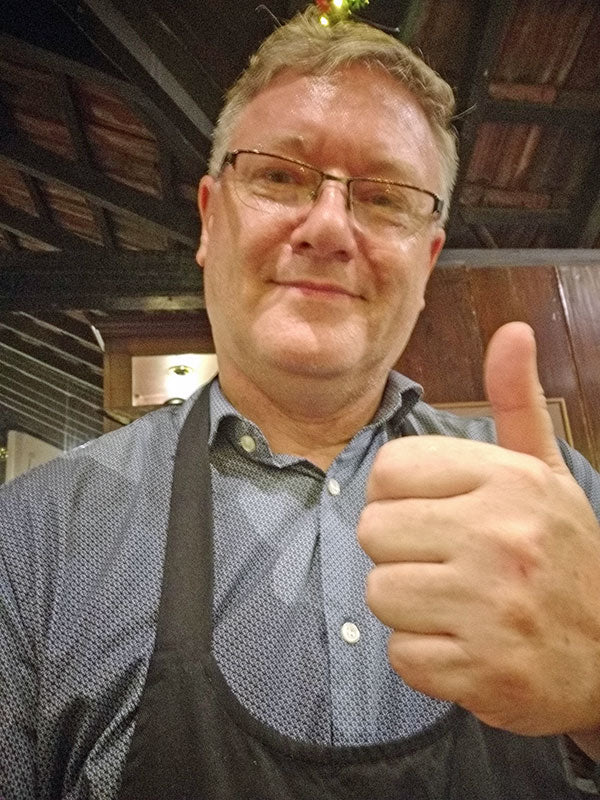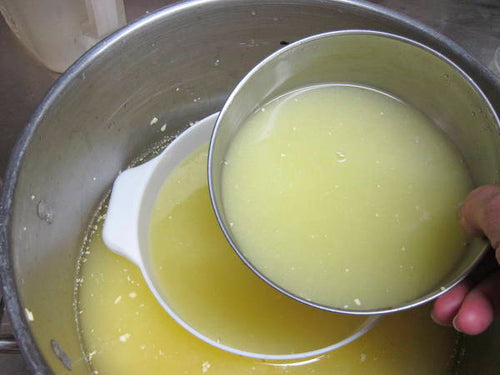When I first contacted Paulette about doing this interview she was reluctant. She wrote “I don’t know if you would find me nearly as interesting as the other people you interview. I’m always in awe of the folks you feature.”
Then she started sending me pictures of her cheese and I knew she was about as interesting as it gets! See what you think …
Paulette’s Story
I’m 67, retired, and happily married to my husband for 35 years. We live outside of Cincinnati, OH, in West Chester Township.
We have two grown sons, Zack and Josh. They love serving my cheese and bragging that their mom can do this.
I love making things (sewing, cooking, baking, tatting, etc.), but had never thought about cheese making until I read Animal, Vegetable, Miracle by Barbara Kingsolver. In that book, she mentions making her own mozzarella cheese, and it was like my head exploded!
I needed to learn how to do that! (This book also led me to the New England Cheesemaking Company (NECS) and the rest is history.)
At the time, around 2009, I was still employed and working long hours, so initially I limited myself to the soft cheeses I could make from your Beginner Cheese Making kit – mozzarella, ricotta, cottage cheese.
As soon as I retired 10 years ago, I purchased the Basic Cheese Making kit, and worked my way through those recipes, and branched out to the recipes in your book (Home Cheese Making).
Making Cheese
Keeping Records:
I use the 33 Wheels of Cheese Cheesemaking Log to keep track of my work. Keeping a log of my cheeses makes it much easier to keep track of what we like best.
I like to make a note of where I got the recipe, so I can refer to the recipe book, or website, if I want to make the recipe again.
Finding good milk:
In Ohio, it is illegal to sell raw milk for human consumption. Here in the Cincinnati area, we have a treasure of a store called Jungle Jim’s International Market, which is a cross between a crazy grocery store (that stocks absolutely everything) and an amusement park.
Jungle Jim’s sells low temp pasteurized, non-homogenized milk from two local dairies. During the quarantine, I decided to use all that time at home making cheese twice a week.
Because we were severely limited in the amount of milk we could purchase from stores, I turned to an on-line service in our area that provides all organic foods delivered to your home. In my case, I have low temp pasteurized, non-homogenized milk delivered from a semi-local dairy when I don’t go to Jungle Jim’s.
Coagulating the milk:
My pro-tip for home cheese makers is to invest in a sous vide wand for easy temperature controls. My one complaint about making cheese was being tied to the kitchen watching milk temperatures, and the sous vide solved that problem for me.

Curds draining for the Blue By You recipe.
Molding:
I have tried re-purposing containers for molds, but now I use “real” molds, purchased from your website, and other companies when I find a sale on something I want. I like the more professional look of a nice mold and well-fitting follower.
I love the manchego mold, and several others pictured. I usually make two gallon batches because when I was getting started, most of Jim’s Wallace’s recipes were two gallon, which led to me buying that size pot and molds for that size batch.

My current favorite molds, all from NECS. They are, left to right, manchego mold (2 lbs), hard cheese mold (small) and rectangular cheese mold (2 lbs).
I found the mold below in a second hand store. It’s originally from a child’s toy kitchen, but it’s marked as food safe. My husband drilled drainage holes for me.

English Coulommiers from Home Cheese Making
Pressing:
The cutting board arrangement below was my first press, obviously homemade.
It worked until I needed to press with heavier weights.
Then, my son built me a Dutch press out of wood and metal scraps laying around our house. It could provide heavier weight for pressing, but became unstable after a few years.
Now, I use the two bucket method. It’s my favorite press so far.
Our grocery store gives away buckets that cake icing comes in, so I know the buckets are food safe.
Drying the cheese:
Funny story about my drying box! I had always dried my cheeses in my basement, covered with a little food umbrella. Then, in September 2020, I found a drying cheese munched on by mice overnight! First, I threw away the cheese, then got rid of the mice, then decided I did not want a repeat of this experience, so I purchased the box at a craft store, sealed it with a food safe rub, and covered the outside with wire mesh window screen. No more cheese lost to mice!
Aging:
Originally, I waxed most of my cheeses, but eventually, I switched to vac packing. It’s quicker and easier than waxing. Except for the rare natural rind cheese, blue, bloomy rind or washed rind cheese, I vac seal my cheeses within a few days of drying.
It is also convenient when we open a cheese but don’t want to eat it all at once. We can seal part of the cheese back up and know it will stay fresh. I give away most of my cheese because I make more than we can eat, and it’s convenient for people who want the cheese but may not be ready to eat it right away.
I have two caves. I make sure that I never put blue cheeses in the smaller cave, so I can age natural rinds without getting a blue infestation!
Both refrigerators were cast offs and I only had to buy Inkbird controllers to turn them into caves.
As you can see from the photo, bottles of wine fit nicely into the bottom of the larger cave.
Since I vac seal most of my cheese, humidity is not an issue. If a cheese is not sealed, I use a ripening box to keep it away from the other cheeses and raise the humidity for the unsealed cheese. I still keep a thermometer/hygrometer in the cave so I know the conditions in the cave.
My Cheese
My go-to’s, so far, are Morbier and Desert Sunset Pave because they are just beautiful and delicious.

Desert Sunset Pave. This could be the favorite, among my friends, of my washed rind cheeses. I love it, but it turns sour within a week of opening.
I like to keep gouda, colby, or havarti in the house for use in our regular meals.
I make a variety of blues.

That was my most successful blue cheese to date. I aim for a nice, white paste, and this is the best paste so far.

Another effort at Blue By You, but I was distracted while making it, and forgot the culture and had to add it late, I got the temperature wrong several times in the making, and even forgot to turn off the heat and was shocked to find my milk at 130 degrees! Even though it was dryer than my other Blue By You efforts, my friend said it was hands down the best tasting blue cheese so far. (Since there were so many changes to the recipe, someone suggested I call it Blue By Paulette.)

This is simply called Blue Cheese, in the Home Cheese Making book. It was too moist, and you can see the yellowish, damp area around the rind on one end of the cheese. I cut that off, and counted this as a success, even though it was a little too salty and VERY strong smelling! This may have been my very first blue cheese

Camblu #2. True to form for me, a bloomy rind cheese that is not what I hoped for! It was dense and hard. A friend and I agreed, though, that it was wonderful on baked potatoes, so it was not made in vain.
Right now, I have a Gorgonzola Dolce and Blue Stilton aging in my cave.
I have failed miserably with all the bloomy rinds I have attempted, but I just keep on trying, and trying.

Charouse was my first foray into bloomy rind cheese. It more closely resembled an ammonia factory than anything edible!

Brie, that was too damp the entire time I aged it. The picture cannot express the disappointing ammonia aroma from this cheese.

Brie Nuit. This was so firm, you can see it held a knife upright! It really had no flavor at all. It was my second attempt with this recipe. My first attempt had more flavor and was not quite as difficult to cut. I’m told I’m over-reacting to my early failures with bloomy rinds that were too damp, and now I’m drying them out too much. Sigh.

Camembert, using a recipe that had a misprint, and called for three times the salt that was actually required for the cheese. Needless to say, it was too salty to eat, and also, too firm.

Another Camembert, using the same recipe as Picture 2, but using the correct amount of salt. It stayed firm for weeks, so I kept aging it, full of high hopes. Then, one day, it felt soft, so I opened it … delicious Camembert soup! I’m not sure we can call this a win.

Robiolini. It had a good mushroomy flavor, but was much firmer than my goal. Still, it was edible, so it surpasses most of my bloomy rind attempts!
I have not given up on making this category of cheese because they are so delicious (normally). Where my bloomy rinds are concerned, I feel very much like Annie, in that there’s always tomorrow!
My favorites to make and eat are the washed rind cheeses. They are so tasty and difficult to purchase in the store because of their short shelf life.

This is an outstanding cheese! It is beautiful to serve, and has such an individual, complex flavor! A caution for those making this cheese—it is quite aromatic while aging, but worth all the dirty sock odors that permeate our basement.

I was not familiar with this washed rind cheese until I happened across a recipe for it. Raclette is known for the practice of melting sections of raclette and then spreading the melted cheese on vegetables, bread, or meat. I do not have a raclette melter, so I used my creme brulee torch to melt pieces of cheese onto my vegetables. The charring of the cheese gives it such a smoky, rich flavor. I suggest this for people who want to go the extra step of melting cheese on food.
Reblochon (Jim’s recipe) is a washed rind cheese that is simply divine. I use pasteurized milk and I think this cheese is heavenly. I cannot imagine how good it would be with raw milk, as Jim Wallace suggests.
If I need a cheese in a hurry, I make your English Coulommiers.
I like to try new recipes and I enjoy Jim’s Recipe of the Month (in the Moos-Letter). Before I started making cheese I had no idea how many varieties exist out there to try.

December, 2021, Recipe of the Month – Formaggio val campella, drying before going into the cave. I’ve named this cheese Mr. Marshmallow because he’s so big and poofy.
Cheddar:
What I have learned about making cheddar cheese is: I don’t really like my cheddars. I feel like they are labor intensive (and in the cheese world, that says a lot!), and the flavors are usually just not as good as I would like.
I also learned, to my astonishment, that I don’t like cheeses that have alcohol in them! As a result, I don’t make cheddars unless I receive a specific request.

Stirred curd cheddar with jalapeno peppers, my first attempt at stirred curd cheddar. My husband grew and dried the jalapenos. I thought I would give this recipe a try and see if the stirred curd recipe worked out better for me. The answer was, no! There was nothing wrong with it, it just lacked the flavor punch of cheddar that I like.

My first attempt to add flavor to my cheddar cheese with beer! This was definitely a “learning experience,” as the cheddar lacked flavor, and the beer made it smell icky.

This picture and the next reflect my efforts to make a good cheddar. I researched cloth bound cheddars, and read that the cloth and mold growth allowed a deeper cheddar flavor to develop. I’m a little mold-wary, and when the cheese began growing mold, I got worried. I opened it up, cleaned it up, and again added a cloth binding.

Yet another attempt at cheddar. At least it looks good! The paste and color are fine, but again, it lacks flavor.

This was made for my son, Josh. His favorite brewery at the time was Hoppin’ Frog Brewery in Akron, so I made this for him. He said he liked it, but it was very beer-y, and not very cheddar-y, in my opinion.
Other cheeses:

Alpine Tomme is a good mild cheese that works well in grilled cheese sandwiches, sliced on crackers, or added in cubes to salads. In the recipe I used from NECS, I dried the rind for a couple of weeks, and only used a brine wash to stop any developing mold, then waxed it for aging.

Cabra al Vino, one of the few goat cheeses I have made. It was very, very good, with only a mild hint of goat! (I have to drive two hours to buy nice goat milk, so I normally just use cow’s milk.)

Provolone…my provolone always ends up looking kind of like fortune cookies. I just cannot get the knack of shaping it properly. We love this cheese plain, or aged with an olive oil/smoked paprika rub.
A Few of My Other Hobbies
My husband, Russ and I like to hike year round, with our dog, Dino, we follow college basketball in the winter, and we play croquet in the summer.
I raise Mason bees, which are non-aggressive, super-pollinating bees. They are solitary bees, which means they don’t live in a hive, or make honey, but live in tunnels in nature, or bamboo tubes in bee houses. They are native to the US.
My yard is a Certified Wildlife Habitat. That means my yard, registered with the National Wildlife Federation, provides food, water, cover and places for wildlife to raise their young.
My yard is also a certified Plant for Pollinator Garden.

An arbor I made, by taking an old metal gazebo frame, and growing flowering trumpet vines up the sides and across the top.
I became a Master Gardener in 2013. Master Gardeners can be found throughout the US.
In my area, we need to complete 50 hours of classroom training, pass an exam, and volunteer 50 hours to earn Master Gardener certification.
I volunteer my time educating the public using science-based information on horticultural and environmental issues. I also contribute by working in educational planting areas throughout my county.

Here I am with a fellow Master Gardener, at a park near my home. The park held an Arbor Day celebration and asked us to educate visitors about Mason bees. Mason bees are excellent helpers in pollinating apple trees and other flowering trees, in addition to flowers.
A Final Thought
Cheese making is fascinating to me, but rather lonely, as I don’t know one other person who wants to do this. I had so many questions!
Jim Wallace always answers my questions quickly and patiently, but since he probably has other things to do, I started looking around, and found several cheesemaking Facebook groups. Those groups have given me “cheese friends” and also led to me the world of YouTube cheese making videos. I have picked up tips, found new recipes, and I enjoy seeing what other people are doing.






























